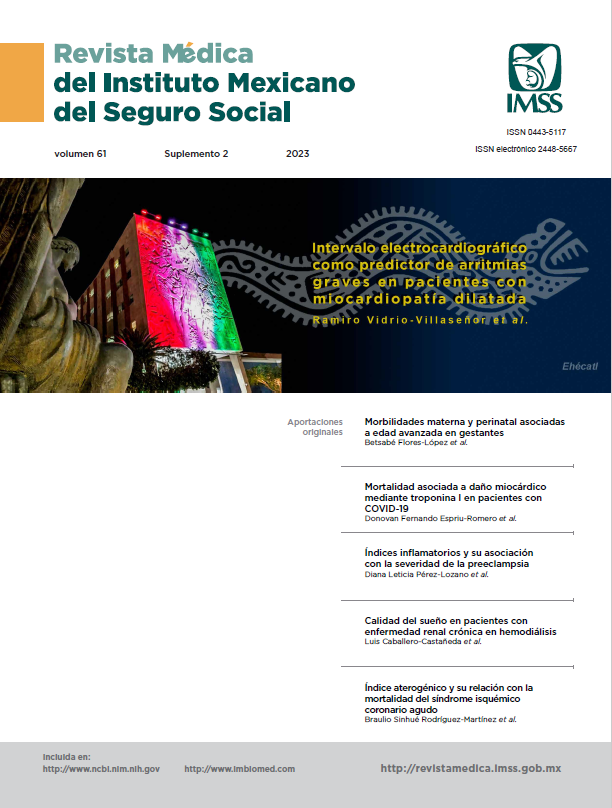Utilidad pronóstica de los índices inflamatorios en recién nacidos críticamente enfermos
##plugins.themes.themeEleven.article.main##
Palabras clave
Recién Nacido, Enfermedad Crítica, Inflamación, Neutrófilos, Linfocitos
Resumen
Introducción: los recién nacidos (RN) críticamente enfermos son susceptibles de mal pronóstico debido a su sistema inmunitario inmaduro.
Objetivo: conocer la utilidad pronóstica de los índices inflamatorios en RN críticamente enfermos.
Material y métodos: estudio observacional, analítico, longitudinal, prospectivo. Incluimos RN hospitalizados, críticamente enfermos y no críticos, que contaran con biometría hemática completa a las 12 horas de vida (inicial) y dentro de las 24 horas previas al egreso por mejoría o defunción (final). Se analizó el Índice inmunosistémico (IIS), neutrófilos linfocitos (INL) y plaquetas linfocitos (IPL). Hubo seguimiento desde el nacimiento hasta el egreso. Resultados: se analizaron 211 pacientes, de 33 (32-34) semanas de gestación, peso 1.569 (1.480-1.720) kg; 106 RN críticos y 105 no críticos, con 50 defunciones en los primeros. El INL final ≥ 1.38 (sensibilidad [S] 58%, especificidad [E] 58%, ABC 0.60 [p 0.006]) identificó RN críticamente enfermos con respecto a RN no críticos; INL final ≥ 1.84 (S 71%, E 71%, ABC 0.79 [p < 0.0001]) identificó RN críticamente enfermos que fallecieron con respecto a todos los que sobrevivieron; el IIS final ≥ 255.411 x 103 (S 55%, E 56%, ABC 0.60 [p 0.047]) e INL final ≥ 1.75 (S 76%, E 76%, ABC 0.84 [p < 0.0001]) identificaron a RN críticamente enfermos que fallecieron con respecto a los que sobrevivieron.
Conclusiones: el INL final predice que RN pueden fallecer con respecto a todos los que sobreviven. El INL y el IIS finales predicen entre los RN críticamente enfermos quiénes pueden fallecer.
Referencias
Abayneh G. D., Fentahun A., Mahlet A., Gizaw Z. T. Patterns of admission and factors associated with neonatal mortality among neonates admitted to the neonatal intensive care unit of Univesity of Gondar Hospital, Northwest Ethiopia. Pediatric Health Med Ther. 2017; 8: 57-64. DOI: 10.2147/PHMT.S130309.
Jacob J.J., Kamitsuka M., Clark R. H., Kelleher A. S., & Spitzer A. R. Etiologies of NICU Deaths. PEDIATRICS. 2015; 135(1): 59–65. DOI: 10.1542/peds.2014-2967.
Liu L., Johnson H. L., Cousens S., Perin J, Scott S, Lawn JE, et al. Global, regional, and national causes of child mortality: an updated systematic analysis for 2010 with time trends since 2000. Lancet. 2012; 379: 2151-2161. DOI: 10.1016/S0140-6736(12)60560-1.
World Health Organization. Children: improving survival and well-being. Geneva: WHO; actualizado el 8 de septiembre de 2020. Disponible en: https://www.who.int/es/news-room/ fact-sheets/detail/children-reducing-mortality
World Health Organization. Newborn Mortality. Geneva: WHO; 28 January 2022. Disponible en: https:// www.who.int/news-room/fact-sheets/detail/levels -and-trends-in-child-mortality-report-2021.
Instituto Nacional de Estadística y Geografía. Mortalidad. Conjunto de datos: Defunciones registradas (mortalidad general). México: INEGI; 2022. Disponible en: https://www.inegi. org.mx/sistemas/olap/proyectos/bd/continuas/mortalidad/ mortalidadgeneral.asp?s=est&c=11144&proy=mortgral_mg#.
Instituto Nacional de Estadística y Geografía. Natalidad. Conjunto de datos: Nacimientos. México: INEGI; 2022. Disponible en: https://www.inegi.org.mx/sistemas/olap/Proyectos/bd/ continuas/natalidad/nacimientos.asp.
Lord JM, Midwinter MJ, Chen YF, Belli A, Brohi K, Kovacs EJ, et al. The systemic immune response to trauma: an overview of pathophysiology and treatment. Lancet. 2014;384(9952):1455- 65. doi: 10.1016/S0140 6736(14)60687-5.
Shane AL, Sanchez PJ, Stoll BJ. Neonatal Sepsis. Lancet. 2017;17:1-11. doi: 10.1016/S0140-6736(17)31002-4.
Márquez-González H, Muñoz-Ramírez MC, Ramírez-García MA, Pineda-Frutos MA, Hernández-Ramírez C, Villa-Romero AR et al. La hiperglucemia como factor predictor de mortalidad en neonatos críticamente enfermos. Rev Med Inst Mex Seguro Soc. 2014;52 Supl 2:S104-9. Disponible en: http://revistamedica.imss.gob.mx/editorial/index.php/ revista_medica/article/view/785/1331.
Rosales-López SL, Fernández-Hernández JP, Hernández-González MA, Solorio-Meza SE, González- Carrillo PL, Guardado-Mendoza R. Delta del índice neutrófilo linfocito y mortalidad en infección COVID-19. Rev Med Inst Mex Seguro Soc. 2022;60(6):640-8.
Che-Morales JL, Cortes-Telles A. Índice neutrófilo/linfocito como biomarcador sérico asociado con neumonía adquirida en comunidad. Rev Med Inst Mex Seguro Soc. 2018;56(6):537-43.
Hornik CP, Benjamin DK, Becker KC, Benjamin DK, Li J, Clark RH, et al. Use of the complete blood cell count in early-onset neonatal sepsis. Pediatr Infect Dis J. 2012;31(8):799-802. doi: 10.1097/INF.0b013e318256905c.
Liu X, Shen Y, Wang H, Ge Q, Fei A, Pan S. Prognostic significance of neutrophil-to-lymphocyte ratio in patients with sepsis: a prospective observational study. Mediators Inflamm. 2016;2016:8191254. doi: 10.1155/2016/8191254.
Zhang S, Luan X, Zhang W, Jin Z. Platelet-to-Lymphocyte and Neutrophil-to-Lymphocyte Ratio as Predictive Biomarkers for Early-onset Neonatal Sepsis. J Coll Physicians Surg Pak. 2021;30(7):821-4. doi: 10.29271/jcpsp.2021.07.821.
Aydogan S, Dilli D, Soysal C, Akduman H, Örün UA, Taşar M, et al. Role of systemic immune-inflammatory index in early diagnosis of sepsis in newborns with CHD. Cardiol Young. 2022; 32(11):1826-32. doi: 10.1017/S1047951122001202.
Ceran B, Alyamaç Dizdar E, Beşer E, Karaçağlar NB, Sarı FN. Diagnostic Role of Systemic Inflammatory Indices in Infants with Moderate-to-Severe Hypoxic Ischemic Encephalopathy. Am J Perinatol. 2021. doi: 10.1055/a-1673-1616.
Kocaaslan R, Dilli D, Çitli R. Diagnostic Value of the Systemic Immune-Inflammation Index in Newborns with Urinary Tract Infection. Am J Perinatol. 2022;doi:10.1055/s-0042-1757353.
Akdogan M, Ustundag Y, Cevik SG, Dogan P, Dogan N. Correlation between systemic immune-inflammation index and routine hemogram-related inflammatory markers in the prognosis of retinopathy of prematurity. Indian J Ophthalmol. 2021;69(8): 2182-7. doi:10.4103/ijo.IJO_2745_20.
Yang Y, Cao ZL, Zhou XY, Chen XQ, Pan JJ, Cheng R. Does neutrophil/lymphocyte ratio have good diagnostic value in neonatal necrotizing colitis? J Matern Fetal Neonatal Med. 2019 Sep;32(18):3026-3033. doi: 10.1080/14767058.2018.1455182.
Zhang J, Zeng J, Zhang L, Yu X, Guo J, Li Z. The Utility of Peripheral Blood Leucocyte Ratios as Biomarkers in Neonatal Sepsis: A Systematic Review and Meta-Analysis. 2022; Front Pediatr. 10:908362. doi: 10.3389/fped.2022.908362.
Panda SK, Nayak MK, Rath S, Das P. The Utility of the Neutrophil-Lymphocyte Ratio as an Early Diagnostic Marker in Neonatal Sepsis. Cureus. 2021;13(1):e12891. doi: 10.7759/ cureus.12891
Tanacan A, Uyanik E, Unal C, Beksac M. A cut-off value for systemic immune-inflammation index in the prediction of adverse neonatal outcomes in preterm premature rupture of the membranes. J Obstet Gynaecol Res. 2020;48(8):1333-41. doi: 10.1111/jog.14320.
Arcagok BC, Karabulut B. Platelet to lymphocyte ratio in neonates: a predictor of early onset neonatal sepsis. Mediterr J Hematol Infect Dis. 2019;11(1):e2019055. doi: http://dx.doi. org/10.4084/MJHID.2019.055.
Feng W, Hou J, Xiang C, Die X, Sun J, Guo Z, et al. Correlation of systemic immune-inflammation Index with surgical necrotizing enterocolitis. Front Pediatr. 2022;10:1044449. doi: 10.3389/fped.2022.1044449.


